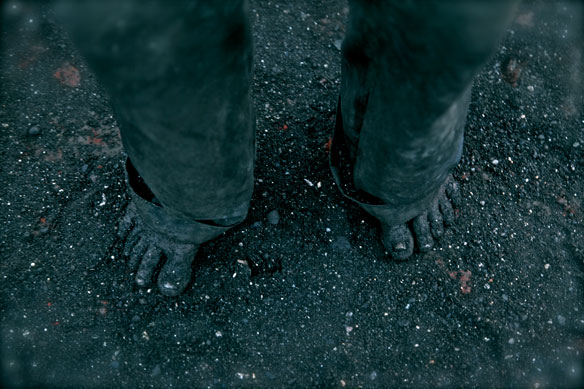
Encounter with an illegal sand miner, Mumbai.
“Sand is the second most consumed natural resource, after water. The construction-building industry is by far the largest consumer of this finite resource. The traditional building of one average-sized house requires 200 tons of sand; a hospital requires 3,000 tons of sand; each kilometer of highway built requires 30,000 tons of sand… A nuclear plant, a staggering 12 million tons of sand…” Captions and Photograph by “Sand Wars” Award-Winning Filmmaker: © Denis Delestrac (2013).
Excerpts;
The city of Mumbai is an ever expanding asphalt jungle, as well as other indian metropolises like Bengaluru, Delhi and Hyderabad, that are witnessing a similar growth in urban infrastructure.
India’s booming 157 billion dollar construction sector is expected to grow in the coming years. This means that the demand for sand and other minor minerals will increase as well, making it more difficult for the government to curb the methodical and unlawful abuse of riverbeds and coastal areas…
Read Full Article, YourStory (09-19-2016)
Tragedy of The Commons: Corrosive Growth of the Illegal Sand Mining Mafia, The Citizen (01-04-2016)
Not many people may know that illegal sand mining is a nationwide phenomena in India, and with spurt in housing and infrastructure projects, the illegal sand mining is thriving beyond the ambit of formal economy and law and order. Sand is everywhere and so is the sand mafia…
India’s ‘New Cities’ Plan: Environment Not Included, Aljazeera (03-06-2015)
Sand – inexpensive and abundant – is a treasure to India’s builders and the construction industry, which employs some 40 million people. But the spike in construction means sand mining, both legal and illegal, will increase in coastal areas, riverbeds, creeks, and rivulets…
Illegal Sand Mining is New Gold Rush in India, Gulf News (07-23-2013)
India’s beach sand-mining industry set to prosper under private sector (07-14-2016)
With the strangulation of rare earth supplies by China, India’s beach sand-mining industry has received a fillip to develop and expand…
Trimex to invest Rs. 2,500 cr. on beach sand mining, Andhra Pradesh; The Hindu (01-19-2016)
Indian mineral sand producer Trimex Group, will invest Rs. 2,500 crore (373 million USD) on mining beach minerals at Bhavanapadu and Kalingapatnam, two coastal areas of Andhra Pradesh state, located on the southeastern coast of the country. The company proposes the mining of 10 MTPA (10 million tonnes per annum) of heavy mineral sand along with pre-concentration plant of 1,525 tonne per hour…
Sand scarcity hits Mumbai’s first artificial beach project, DNA India (08-22-2016)
People on Coastline Suffering Due to Sand Mining, India; a NEWS X LIVE Video (08-19-2013)
Disappearing Beaches of India, The Hindu (06-06-2015)
Sand, Rarer Than One Thinks: A UNEP report (GEA-March 2014)
Despite the colossal quantities of sand and gravel being used, our increasing dependence on them and the significant impact that their extraction has on the environment, this issue has been mostly ignored by policy makers and remains largely unknown by the general public.
In March 2014 The United Nations released its first Report about sand mining. “Sand Wars” film documentary by Denis Delestrac – first broadcasted on the european Arte Channel, May 28th, 2013, where it became the highest rated documentary for 2013 – expressly inspired the United Nations Environment Programme (UNEP) to publish this 2014-Global Environmental Alert.
Sand Wars, An Investigation Documentary, By Award-Winning Filmmaker Denis Delestrac (2013)








